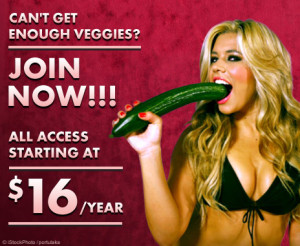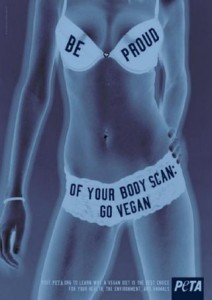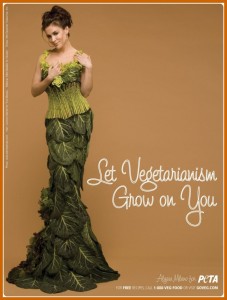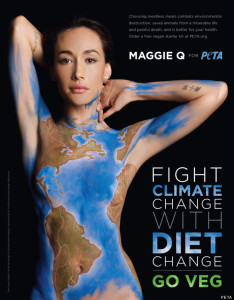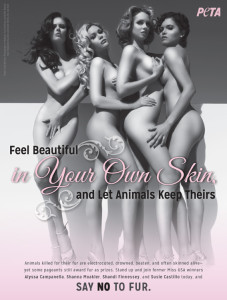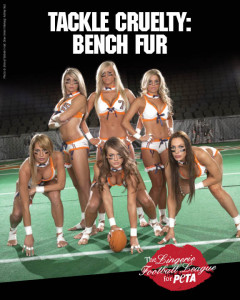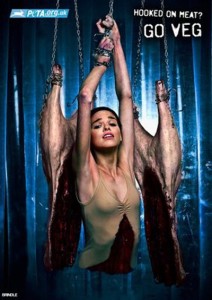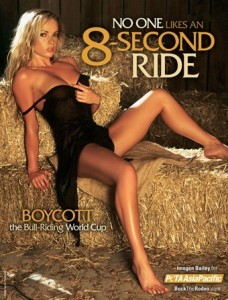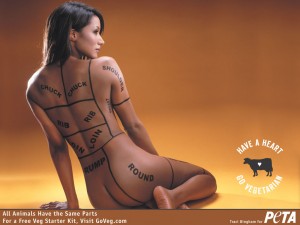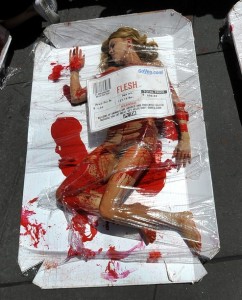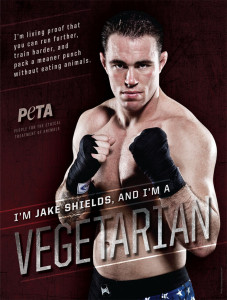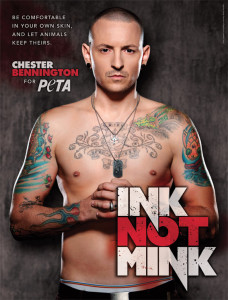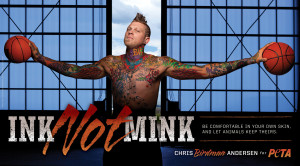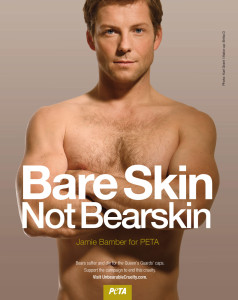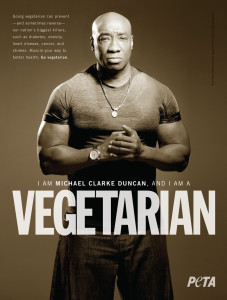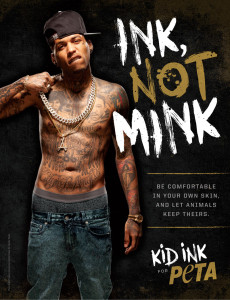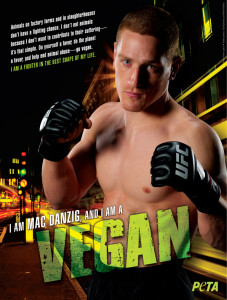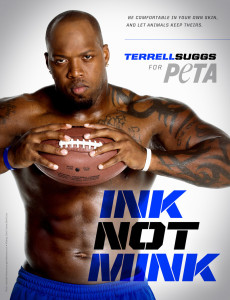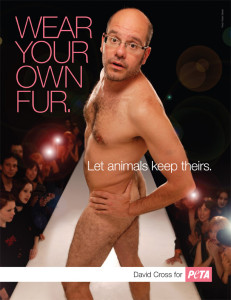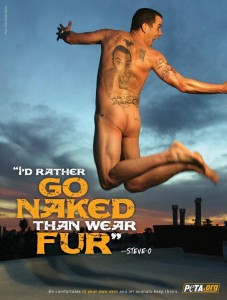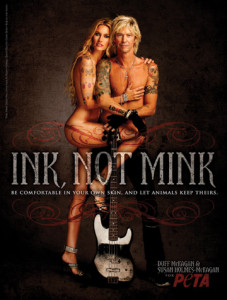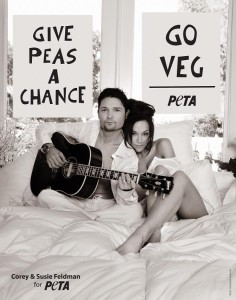Advertencia: Este artículo contiene imágenes pornográficas, se recomienda no leerlo en el trabajo.
Si ustedes recuerdan, hace un par de años, PETA lanzó una página web de pornografía en la cual se mezclaban escenas explicitas de violencia con imágenes sexuales de mujeres ¿Parece un mensaje positivo y coherente, ¿no cierto? afortunadamente, las imágenes de las mujeres fueron removidas, y la página web de porno, no es más que videos cortos de granjas de cría intensiva. Sin embargo, las personas vienen por las imágenes morbosas de mujeres usadas como objetos sexuales, y son expuestos a la violencia explicita. La perturbadora conexión entre sexo y violencia permanece intacta.
En cualquier caso, la pornografía de PETA está de vuelta con un proyecto llamado “Veggie Love Casting Session.” En mi opinión, este es sin lugar a duda el material más obsceno que PETA haya producido con las donaciones bien intencionadas de personas que realmente se preocupan por el sufrimiento de los animales.
¿Conviértase en un miembro de PETA para ver más porno? ¿O para ayudar a los animales no humanos?
En la página web, se encuentran diferentes videos cortos de mujeres realizando actos sexuales con vegetales. En el comercial, las mujeres desfilan delante de la cámara y son inspeccionadas como si fueran esclavas en la tarima de subastas, como si fueran carne humana lista para consumir. Este proyecto es liderado por hombres, los cuales toman las decisiones. Al fondo se escuchan las voces masculinas dando instrucciones a las mujeres, pidiéndoles que “muestren cuanto les gusta” el vegetal que se les asigno; para finalmente reírse de la humillación de ellas al final de la sesión. Las fotos de estas mujeres están incluidas al final de la página web donde los espectadores puedan otorgarles una calificación con “pulgar arriba” para darles su aprobación o “pulgar abajo” para darles un voto negativo, tratándolas como objetos de forma descarada.
Hermanas gemelas cometiendo incesto para abogar por los derechos de los animales no humanos para la diversión de los directores de PETA del género masculino y los espectadores.
PETA imita perfectamente la desagradable prevalencia del racismo en la pornografía. La única mujer Afroamericana que aparece en el video es presentada como si fuera un animal, gateando en el sofá hacia un brócoli el cual devora sin usar sus manos.
Muchas personas argumentarían que estas mujeres hacen esto por “elección propia” y porque lo “disfrutan”. Hasta cierto punto esto es probablemente cierto. Pero este argumento carece de objetividad. Tomen en cuenta los factores que determinan esas elecciones: un ambiente en el cual las mujeres son vistas como objetos sexuales y como un medio para el entretenimiento masculino. Las mujeres tienen una gran presión para asumir los roles correspondientes a su género. Bajo un patriarcado, las mujeres son socializadas para que sean esclavas de los hombres. Las mujeres son preparadas como niñas pequeñas, a las cuales se les educa en la premisa que se espera y que es obligatorio que ellas provean sexo y placer al hombre. En este mundo, las mujeres tiene pocas oportunidades para ser exitosas con base en sus habilidades, conocimiento, y otras cualidades dignas; el trabajo sexual es una de las pocas opciones disponibles. Esta opción ni siquiera es contemplada para los hombres.
Por cierto, la pornografía y otras formas de explotación sexual tienden a utilizar especialmente a mujeres vulnerables, aquellas provenientes de familias de bajos recursos, o de un ambiente familiar violento o con pocas oportunidades laborales o educacionales, y también aquellas mujeres que sufren de adicciones. La pornografía lastima a todas las mujeres pero especialmente a las mujeres en riesgo.
Mujer dándose una zurra con un apio para que los espectadores masculinos aprendan acerca de especismo
Cuando los visitantes de esta página web terminan de ver los videos de las mujeres realizando actos sexuales con vegetales, aparecen videos de animales que son golpeados y asesinados…porque nada es más sexy que colocar la imagen de una mujer siendo explotada junto a la imagen de una animal que está agonizando. Esto es en realidad lo que se ha hecho de la sexualidad: Subyugar y herir a los vulnerables para el placer de los privilegiados. Observar a alguien humillado y sufriendo para nuestro entretenimiento se ha convertido en algo sexy.
Mujer pretendiendo que tiene sexo con tomates para educar a otros acerca del veganismo
PETA está dando una connotación sexual a la degradación y humillación de las mujeres. PETA le da una connotación sexual a la explotación de la población vulnerable. PETA dota de sexualidad a la violencia hacia la mujer. PETA otorga una connotación sexual a la opresión.
La investigación es abrumadoramente clara. La pornografía conlleva a la degradación de la mujer, a ver a la mujer como un objeto, a la deshumanización de la mujer y a la violencia hacia la mujer. Esto hace que las mujeres internalicen esta devaluación y que ellas mismas se vean como objetos. Les quita poder y permite que sean susceptibles a la violencia intrafamiliar, alimenta la cultura de la violación. Para mayor información en qué manera la pornografía lastima a las mujeres, échele un vistazo a The Price of Pleasure (se advierte que es extremadamente provocador y gráfico). Haga un poco de búsqueda en la internet para encontrar esta video gratis.
Sus donaciones de PETA siendo utilizadas para la explotación de las mujeres.
Sostengo que abogar con tácticas sexistas es un insulto despreciable hacia nuestro importante movimiento por la justicia social. PETA asesina a los animales, (visite el enlace PETA kills animals) y asesina a las mujeres de manera simbólica. Por favor, por el amor hacia cualquier cosa buena que exista en este mundo, nunca vuelvan a hacer donaciones a PETA, no permitan que sus amigos y familias hagan donaciones. Ustedes no necesitan a PETA para que haya un cambio verdadero para los Animales no humanos: Promuevan el veganismo de manera pacífica, apoyen la estrategia de atrapar, esterilizar y dejar en libertad (en inglés, trap-neuter-release), apoyen los santuarios de animales veganos, apoyen su refugio de animales local, adopten, luchen contra la opresión de toda clase. RESPETEMONOS LOS UNOS A LOS OTROS en nuestra lucha para acabar con el especismo.
Traducido por Tatiana Rodriguez Labrador
 Dr. Wrenn is Lecturer of Sociology. She received her Ph.D. in Sociology with Colorado State University in 2016. She received her M.S. in Sociology in 2008 and her B.A. in Political Science in 2005, both from Virginia Tech. She was awarded Exemplary Diversity Scholar, 2016 by the University of Michigan’s National Center for Institutional Diversity. She served as council member with the American Sociological Association’s Animals & Society section (2013-2016) and was elected Chair in 2018. She serves as Book Review Editor to Society & Animals and has contributed to the Human-Animal Studies Images and Cinema blogs for the Animals and Society Institute. She has been published in several peer-reviewed academic journals including the Journal of Gender Studies, Feminist Media Studies, Disability & Society, Food, Culture & Society, and Society & Animals. In July 2013, she founded the Vegan Feminist Network, an academic-activist project engaging intersectional social justice praxis. She is the author of A Rational Approach to Animal Rights: Extensions in Abolitionist Theory (Palgrave MacMillan 2016).
Dr. Wrenn is Lecturer of Sociology. She received her Ph.D. in Sociology with Colorado State University in 2016. She received her M.S. in Sociology in 2008 and her B.A. in Political Science in 2005, both from Virginia Tech. She was awarded Exemplary Diversity Scholar, 2016 by the University of Michigan’s National Center for Institutional Diversity. She served as council member with the American Sociological Association’s Animals & Society section (2013-2016) and was elected Chair in 2018. She serves as Book Review Editor to Society & Animals and has contributed to the Human-Animal Studies Images and Cinema blogs for the Animals and Society Institute. She has been published in several peer-reviewed academic journals including the Journal of Gender Studies, Feminist Media Studies, Disability & Society, Food, Culture & Society, and Society & Animals. In July 2013, she founded the Vegan Feminist Network, an academic-activist project engaging intersectional social justice praxis. She is the author of A Rational Approach to Animal Rights: Extensions in Abolitionist Theory (Palgrave MacMillan 2016).
Receive research updates straight to your inbox by subscribing to my newsletter.

